How often does the International Space Station have to dodge space debris?
Astronauts have to deal with growing amounts of space junk in orbit, but there are procedures on the International Space Station in case of trouble.
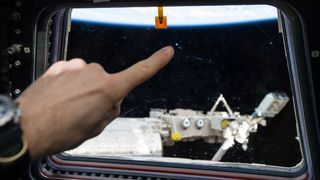
Every so often, space debris gets in the way of the International Space Station.
The International Space Station (ISS) has been in orbit since 1998 and space debris has forced evasive maneuvers dozens of times. According to a December 2022 NASA report, the ISS has course-corrected itself 32 times to avoid satellites and trackable space debris since 1999.
Strikes by micrometeoroids or space debris have been recorded on Russian Progress and Soyuz craft and space robotics like Canadarm2, as well as the wraparound cupola window that faces Earth. But the space debris problem is growing more quickly as more satellites are launched into space, increasing the risk of collisions with the ISS or with each other. Known space debris has forced ISS avoidance maneuvers, required astronauts to take shelter and even canceled spacewalks.
Read on to learn when the ISS has had to dodge debris, how the space station moves out of the way and what happens if NASA and the space station partners can't perform evasive maneuvers in time.
Related: International Space Station facts, history & tracking
When does the ISS have to dodge debris?
The ISS orbit, which is about 250 miles (400 kilometers) above Earth, is more crowded with space junk than ever before. That's in part because the number of satellites is increasing, and in part due to space debris.
NASA's long-standing guidelines require the ISS to maneuver if any satellite comes within a "pizza box"-shaped area of space surrounding the orbit of the station. The box is roughly 2.5 by 30 by 30 miles (4 by 50 by 50 kilometers) with the ISS at the center, according to agency officials. (Trackable pieces in that orbital plane are roughly 2 inches (5 centimeters) in diameter, but even paint flecks can cause issues given the high velocities involved with objects in orbit.)
"When predictions indicate that any tracked object will pass close enough for concern and the quality of the tracking data is deemed sufficiently accurate, Mission Control centers in Houston and Moscow work together to develop a prudent course of action," agency officials wrote in May 2021 of ISS avoidance procedures.
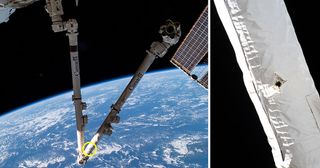
How bad is the space debris problem?
The Union of Concerned Scientists tracked 5,465 active satellites as of May 2022, which is a 12% increase from only six months beforehand (December 2021) with 4,852 recorded satellites. (They base their information off of frequently updated statistics from the United Nations Office of Outer Space Affairs.)
The number of operational satellites currently in orbit is "astounding", wrote Steven Young, the Washington, D.C. union representative, in March 2022. "The number launched this year [2022] is more than the total number of operating satellites in 2016, just six years ago," he said.
The vast majority of new satellites come from SpaceX, which is aiming to have at least 12,000 operational Starlink broadband satellites in low Earth orbit in the near term and has applied for approval for 30,000 more. SpaceX has said it has procedures in place to move Starlinks out of the way of trouble.
"To accomplish safe space operations in a scalable way, SpaceX has developed and equipped every SpaceX satellite with an onboard, autonomous collision avoidance system that ensures it can maneuver to avoid potential collisions with other objects," company officials wrote in a February 2022 update. Starlink numbers nevertheless are numerous.
As of March 2023, SpaceX has launched approximately 4,000 satellites in orbit since its first Starlink group in 2019, according to a table maintained by space object tracker Jonathan McDowell of the Harvard-Smithsonian Center for Astrophysics. An April 2020 peer-reviewed paper from McDowell adds that low Earth orbit has seen "a dramatic increase in the population" of satellites in recent years almost solely as a result of Starlink. Starlink orbits vary, but some have an altitude as low as between 211 and 217 miles (340 to 350 km), his paper shows, which is near that of the ISS.
"It's going to be like an interstate highway, at rush hour in a snowstorm with everyone driving much too fast," McDowell told Space.com in February 2023 when asked what the situation in orbit will be like if Starlink, along with other constellations from OneWeb and Amazon Kuiper are built in full. "Except that there are multiple interstate highways crossing each other with no stoplights."
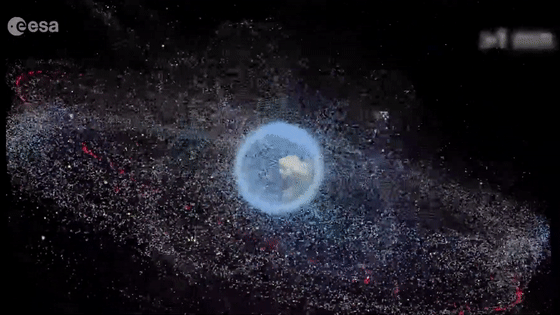
In August 2021, Hugh Lewis, the head of the Astronautics Research Group at the University of Southampton and Europe's leading space debris expert, told Space.com that Starlink satellites represent the single main sources of collision risk in low Earth orbit. Lewis bases his work on the Socrates database (Satellite Orbital Conjunction Reports Assessing Threatening Encounters in Space) provided by CelesTrak. The database publishes information about satellite orbits and models their trajectories for collision estimates.
"I have looked at the data going back to May 2019 when Starlink was first launched to understand the burden of these megaconstellations," Lewis told Space.com in 2019. "Since then, the number of encounters picked up by the Socrates database has more than doubled and now we are in a situation where Starlink accounts for half of all encounters."
Moreover, there are untold thousands of pieces of space debris in low Earth orbit from more than 65 years of satellite and space launches. Some pieces are dead satellites, while some are fragments from collisions, and yet others are stray bits of debris from space activities like stage separations.
The North American Aerospace Defense Command (NORAD) is tracking more than 47,000 space objects overall as of March 2023, according to SpaceTrack.org. Even more bits are too small to track with current technology, too. Any "dead" pieces cannot change their orbits and with no firm plan on cleaning it all up yet, any approaching the ISS leaves controllers with no choice but to move out of the way.
Related: Who's going to fix the space junk problem?
How does the ISS dodge debris?
Given enough notice, cargo vehicles launched to the ISS carry extra fuel so that they can fire their thrusters and adjust the station's orbit when needed to help the laboratory complex avoid space debris. An example situation was on Oct. 25, 2022, when Russian controllers fired thrusters on Progress 81, an attached cargo ship, for five minutes and five seconds to avoid debris, according to a NASA statement.
The maneuver raised the altitude of the ISS by 0.2 miles (0.32 kilometers) at apogee (its farthest point from Earth) and 0.8 miles (1.3 km) at perigee (its closest point to Earth), NASA officials wrote at the time, with no effect to normal space station operations.
The debris was a part of a Russian destructive anti-satellite test performed on Nov. 15, 2021 that received international condemnation. Pieces created by the test have swarmed close to the ISS and to Starlink satellites numerous times, such as in June 2022 when the station had to maneuver to avoid fragments of the shattered Cosmos 1408 satellite.
NASA is also creating backup ability to do maneuvers with U.S. spacecraft, especially after the Russian war with Ukraine that began on Feb. 24, 2022. ISS operations have mostly been normal, but Russia may leave the orbiting complex in 2028 — at least two years before NASA expects to conclude its ISS operations in 2030. In that case, Progress boosts would no longer be available to boost the station out of the way of debris, so NASA tasked a Northrop Grumman Cygnus cargo ship to do a test burn on June 25, 2022. It took two tries to accomplish, but the craft successfully boosted the ISS to its normal operating altitude.
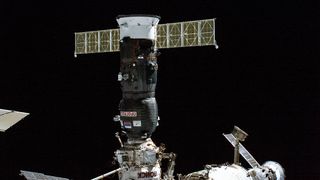
If the ISS can't dodge in time, how does the crew take shelter?
If the crew doesn't have enough notice, or if the tracking data is somewhat imprecise, NASA and the other partners will issue commands to the ISS crew to shelter in place in their escape vehicles.
All astronauts have assigned seats aboard spacecraft, either SpaceX Crew Dragon or Russian Soyuz capsules, that they would ride home in case of emergency. In such situations, ISS crewmembers don spacesuits and await the outcome of the debris incident inside their vehicles; a notable example was in November 2021 when a suspected piece of ASAT debris flew nearby the ISS.
"This [sheltering procedure] allows enough time to isolate those spaceships from the station by closing hatches in the event of a damaging collision," NASA officials wrote in their May 2021 discussion about space debris and the ISS. "The crew would be able to leave the station if the collision caused a loss of pressure in the life-supporting module or damaged critical components. The spacecraft act as lifeboats for crew members in the event of an emergency."
Related: How many astronauts can fly on a SpaceX Crew Dragon capsule?
Between Dec. 14, 2022 and Feb. 25, 2023, NASA and Russia together had to create alternate plans for ISS evacuation when a micrometeroid strike caused a devastating leak in a docked Soyuz, called MS-22. There was no spacecraft coolant available to the stricken vehicle and only two of the three assigned crew members could safely ride home in it. The backup plan in case of ISS emergency was to have the third Soyuz seat, that of NASA astronaut Frank Rubio, mounted on the floor of Crew Dragon Endurance below four of his crewmates. A fresh Soyuz arrived on Feb. 25, 2023 to replace the damaged spacecraft, however, so this emergency scenario did not need to play out.
Costs and complications of dodging debris
A NASA report about addressing space debris released March 10, 2023 also estimates the costs and complications of maneuvering the ISS in case of trouble. Based on numerous public information sources, the report says that each maneuver requires two person-hours of risk analysis. That said, changing the ISS orbit would only be needed in a small minority of possible messages about "conjunctions" or close encounters with space debris (about 2%, the authors estimate).
Roughly 154 pounds (70 kg) of propellant are required to boost the station and then another 154 pounds (70 kg) would be required to lower it. This figure assumes 10% of the propellant would be wasted, however. (That wastage is from an average discussing historical rates of retrograde or opposite-to-motion maneuvers the ISS sometimes needs to perform to move out of the way of space junk, as counteracting its orbital motion requires substantial fuel.)
Based on the cost of cargo being $70,000 per kilogram, a figure obtained from a 2018 report from the NASA Office of Inspector General, the cost per debris-dodging maneuver is about $1 million, the report says. The impact on ISS operations from these events is minimal as ISS crew sheltering activities are rare, and "such measures are unlikely to be needed due to improved risk analysis and maneuver capabilities," according to the report. But debris impacts themselves could be even more costly.
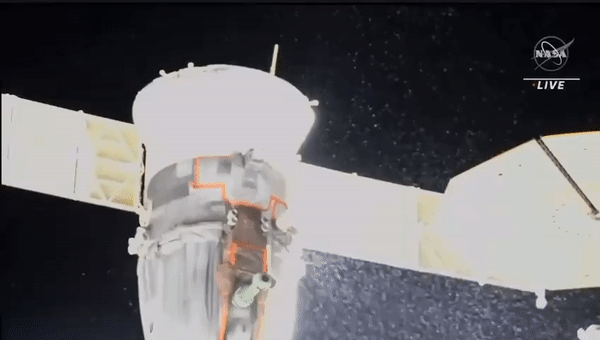
Should the ISS be struck by an object, its design does allow it to withstand "the equivalent of an aluminum sphere with 1 cm diameter", according to a 1997 National Research Council report quoted by the NASA report authors.
The 2023 report assumes an impact would be from an object between 0.4 inches and 4 inches (1 cm and 10 cm) in diameter. The cost to repair such a debris puncture would be at least $200 million, based on OIG figures citing the typical cost of a cargo resupply mission (as a spacecraft would need to go to the ISS bearing necessary materials for repair.) But the cost is likely much higher when taking into account numerous factors like crew time and lost science time, or potential repairs to non-core ISS elements like docked spaceships.
NASA and its space station partners have procedures in place in case of ISS emergencies, but the ever-growing amount of space debris in orbit does cause the orbiting complex problems on occasion. Critics say the key is avoiding space debris in the first place, to clean up any existing space junk as soon as feasible and to possibly reduce the number of satellite launches altogether. It is unclear how space authorities will manage the crowding orbits above Earth, but what is known for sure is that ISS operators will continue to keep a sharp eye out for trouble.
Bibliography
CelesTrak. (2022, July 1). Socrates: Satellite Orbital Conjunction Reports Assessing Threatening Encounters in Space. https://celestrak.org/SOCRATES/
Colvin, J. Thomas, JOhn Karcz and Grace Wusk. (2023, March 10). "Cost and Benefit Analysis of Orbital Debris Remediation." NASA Office of Technology, Policy, and Strategy. https://www.nasa.gov/sites/default/files/atoms/files/otps_-_cost_and_benefit_analysis_of_orbital_debris_remediation_-_final.pdf
McDowell, Jonathan C. (2020, April 6). "The Low Earth Orbit Satellite Population and Impacts of the SpaceX Starlink Constellation." Astrophysical Journal Letters 892, no. 2. https://iopscience.iop.org/article/10.3847/2041-8213/ab8016/meta
McDowell, Jonathan C. (2023, March 3.) Starlink Statistics. https://planet4589.org/space/con/star/spl77/index.html
NASA. (2021, May 26). Space Debris and Human Spacecraft. https://www.nasa.gov/mission_pages/station/news/orbital_debris.html
NASA. (2022, December.) Orbital Debris Quarterly News. Vol. 26, Issue 4. https://orbitaldebris.jsc.nasa.gov/quarterly-news/pdfs/odqnv26i4.pdf
NASA Office of Inspector General. (2018.) Audit of Commercial Resupply Services to The International Space Station. https://oig.nasa.gov/docs/IG-18-016.pdf
NASA Space Station. (2022, Oct. 24). Space Station Maneuvers to Avoid Orbital Debris. https://blogs.nasa.gov/spacestation/2022/10/24/space-station-maneuvers-to-avoid-orbital-debris/
National Research Council. (1997.) Protecting the Space Station from Meteoroids and Orbital Debris. Washington, DC: The National Academies Press. https://doi.org/10.17226/5532
SpaceX. (2022, Feb. 22). "SpaceX's Approach to Sustainability and Safety." Updates. https://www.spacex.com/updates/
Space-Track.org. (2023, March 10.) Space Scoreboard. https://www.space-track.org/auth/login
Union of Concerned Scientists. (2022, May 1). UCS Satellite Database. https://www.ucsusa.org/resources/satellite-database
United Nations Office of Outer Space Affairs. (2023). Online Index of Objects Launched into Outer Space. https://www.unoosa.org/oosa/osoindex/search-ng.jspx?lf_id=
Young, Steven. (2022, March 17). "The Meteoric Rise in Satellite Numbers." Union of Concerned Satellites. https://blog.ucsusa.org/syoung/the-meteoric-rise-in-satellite-numbers/
Elizabeth Howell is the co-author of "Why Am I Taller?" (ECW Press, 2022; with Canadian astronaut Dave Williams), a book about space medicine. Follow her on Twitter @howellspace. Follow us on Twitter @Spacedotcom or Facebook.
Join our Space Forums to keep talking space on the latest missions, night sky and more! And if you have a news tip, correction or comment, let us know at: community@space.com.
Get the Space.com Newsletter
Breaking space news, the latest updates on rocket launches, skywatching events and more!

Elizabeth Howell (she/her), Ph.D., is a staff writer in the spaceflight channel since 2022 covering diversity, education and gaming as well. She was contributing writer for Space.com for 10 years before joining full-time. Elizabeth's reporting includes multiple exclusives with the White House and Office of the Vice-President of the United States, an exclusive conversation with aspiring space tourist (and NSYNC bassist) Lance Bass, speaking several times with the International Space Station, witnessing five human spaceflight launches on two continents, flying parabolic, working inside a spacesuit, and participating in a simulated Mars mission. Her latest book, "Why Am I Taller?", is co-written with astronaut Dave Williams. Elizabeth holds a Ph.D. and M.Sc. in Space Studies from the University of North Dakota, a Bachelor of Journalism from Canada's Carleton University and a Bachelor of History from Canada's Athabasca University. Elizabeth is also a post-secondary instructor in communications and science at several institutions since 2015; her experience includes developing and teaching an astronomy course at Canada's Algonquin College (with Indigenous content as well) to more than 1,000 students since 2020. Elizabeth first got interested in space after watching the movie Apollo 13 in 1996, and still wants to be an astronaut someday. Mastodon: https://qoto.org/@howellspace
-
murgatroyd Fact-filled article, thoroughly researched, copiously referenced. Good job, author! 👍Reply
Now if space.com were to bring this approach to "climate change" articles, instead of uncritically parroting the panic-inducing, fear-mongering dire predictions from the usual suspects ...
Ah who am I kidding. Never going to happen.
